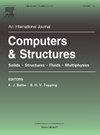俯仰载荷作用下容器内液体晃动非线性分析
IF 4.4
2区 工程技术
Q1 COMPUTER SCIENCE, INTERDISCIPLINARY APPLICATIONS
引用次数: 0
摘要
提出了一种基于比例边界有限元法(SBFEM)的半解析数值模型,用于分析俯仰激励下容器内非线性液体晃动。为了跟踪液体自由表面的运动,采用了半拉格朗日(Semi-Lagrangian, SL)方法,该方法采用两个笛卡尔坐标系,包括固定惯性系和运动系。同时,二阶龙格-库塔算法(RK2)确保了物理变量及其梯度的准确时间更新。在此框架内,利用加权残差法将控制方程和边界条件简化为二阶常微分方程。然后,引入对偶变量来降低方程的阶数。与有限元法相比,该方法只需要边界离散化,同时保持了网格细化的灵活性。解析解程序可在径向,提高精度与较少的自由度沿圆周方向。与边界元法不同,它消除了对基本解的需要,避免了奇异积分。通过对比液体晃动引起的自由表面高程变化和受力变化,验证了该方法的有效性和准确性。计算时间和与计算范式相关的误差进一步证明了该方法的有效性和准确性。随后,系统地分析了激励频率、填充水平和垂直偏心距离对液体晃动行为的影响。最后,研究了底圆角半径对动态晃动力和表面高程的影响。结果表明,所考虑的因素对俯仰激励下容器的表面高程、晃动频率和动动力有不同程度的影响,为减少储液结构的晃动提供了重要的指导和科学依据。本文章由计算机程序翻译,如有差异,请以英文原文为准。
Nonlinear analysis of liquid sloshing in containers under pitching load with scaled boundary finite element method
A semi-analytical numerical model based on the scaled boundary finite element method (SBFEM) is proposed for analyzing nonlinear liquid sloshing in containers subjected to pitching excitation. To track the motion of the liquid free surface, the Semi-Lagrangian (SL) method is employed, with two Cartesian coordinate systems comprising a fixed inertial system and a moving system. Meanwhile, a second-order Runge–Kutta algorithm (RK2) ensures accurate temporal updates of the physical variables and their gradients. Within this framework, the governing equation, along with the boundary conditions, is reduced to a second-order ordinary differential equation using the weighted residual method. Then, dual variables are introduced to reduce the order of the equation for solution. Compared to the finite element method, the proposed approach requires only boundary discretization while retaining mesh refinement flexibility. Analytical solution procedures are available in the radial direction, improving accuracy with fewer degrees of freedom along the circumferential direction. Unlike the boundary element method, it eliminates the need for fundamental solutions and avoids singular integrals. The validity and accuracy of the method are verified against other methods by comparing the change in free surface elevation and forces induced by liquid sloshing. The validity and accuracy of the method are further demonstrated by the computational time and the error associated with the computational paradigm. Subsequently, a systematic analysis is conducted to examine the effects of excitation frequencies, filling levels, and vertical eccentric distance on the liquid sloshing behavior. Finally, how the radius of bottom-rounded corners affects the dynamic sloshing force and surface elevation is investigated as well. The results show that the considered factors affect surface elevation, sloshing frequencies, and the dynamic forces acting on containers under pitching excitation to varying degrees, which may provide important guidance and a scientific basis for sloshing reduction in liquid storage structures.
求助全文
通过发布文献求助,成功后即可免费获取论文全文。
去求助
来源期刊

Computers & Structures
工程技术-工程:土木
CiteScore
8.80
自引率
6.40%
发文量
122
审稿时长
33 days
期刊介绍:
Computers & Structures publishes advances in the development and use of computational methods for the solution of problems in engineering and the sciences. The range of appropriate contributions is wide, and includes papers on establishing appropriate mathematical models and their numerical solution in all areas of mechanics. The journal also includes articles that present a substantial review of a field in the topics of the journal.
 求助内容:
求助内容: 应助结果提醒方式:
应助结果提醒方式:


